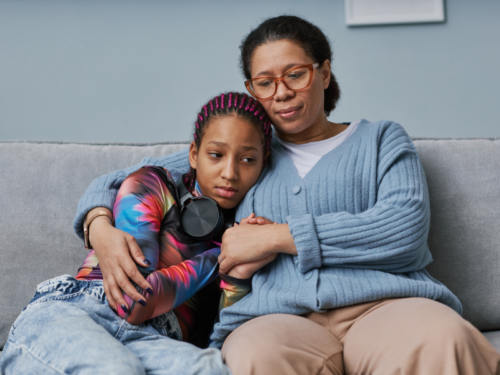
Table of Contents
How Parents Can Support Teens with Depression

Written By: Dr. Rasna Kaur Neelam
October 17, 2022
10 min.
Supporting your teen through depression can be hard. We share strategies and treatment options to make life easier.
Learn more about our Clinical Review Process
Table of Contents
What contributes to an adolescent’s mental health? A teenager’s life experiences, genetics, and family history certainly play a large role. But other factors are involved too.
Social determinants of health are conditions in the environment in which a teen is born, lives, works, plays, and ages. Examples include items like economic stability, transportation availability, education, food and health care access, and more. All of these significantly impact both physical and mental health.
This article will focus on one of the most important social determinants of health: family support systems.
Specifically, this post will discuss changing parent-teen relationships, how healthy and unhealthy relationships can contribute to adolescent depression, and what can change in order to create a healing environment and a reduction in depressive symptoms.
Changes in the Parent-Teen Relationship
In a book entitled Handbook of Parenting: Children and Parenting, psychology researchers analyzed the following potential sources of conflict and change throughout the teenage years:
- Developmental changes of adolescence include the onset of puberty and an increase in sex hormones. This can change the parent-adolescent relationship by changing the way teens and parents view themselves and each other.
- Cognitive changes, in addition to developmental changes, allow teenagers to not only start to look like adults but also to express themselves and think more like adults. Adolescents may also begin to question and think differently about morals, social conventions, and rules. These changes inevitably shake the previously-set balance between parent and child.
- Self-definitional changes include the desire for a teenager to create an autonomous identity distinct from their parents or family.
- Social changes push teenagers to spend less time with family and more time in new social structures with new friends or romantic partners. Living with these social changes, parents may find themselves renegotiating boundaries and worrying about their child driving, using alcohol or drugs, participating in sexual activity, and more.
- Increase in unsupervised time results in greater autonomy of time over which parents may have little or no control.
- Increase in expectations in autonomy in school as teens transition from elementary to middle to high school comes with its own challenges. While in elementary school, parents are often provided direct information about assignments and schoolwork from teachers. But come middle school and especially high school, parents must often rely primarily on their child to keep them informed about their academic endeavors.
- Increased exposure to self-selected mass media may be particularly relevant in today’s social-media obsessed world. Adolescents spend a considerable amount of time consuming media. This is a way for teens to privately talk, socialize, or experiment. Additionally, private social media accounts may create further distance between teens and their parents.
Although the above changes may feel overwhelming, simple positive parenting strategies can help ensure that parent-teen relationships remain healthy and intact.
Do you need more support with
your mental health?
Charlie Health can help.
Healthy Parenting Practices
Research studies have shown that high quality parent-teen relationships can predict many health and behavioral outcomes, including a lower level of adolescent depression. So, what parenting practices best support teens?
One study published in the Journal of Research on Adolescence in 2008 reviewed data on the importance of quality parent-adolescent relationships. Although this is not an exhaustive list, researchers point to the following four qualities as signs of healthy parent-teen relationships:
- Routine family activities
Routine family activities can mean different things to different families. Adolescents in this study were instructed to note the number of days a week that they ate dinner with their family, did a family faith-based activity, or did something fun with the family. Family rituals were found to promote adolescent sense of identity, create greater family cohesion, and helped families push through difficult times.
- Awareness or monitoring of the adolescent
Researchers say that parents with more negative attitudes toward their children are less likely to engage in the appropriate amount of parental monitoring. But parental monitoring and awareness is crucial. Adolescents in this study coded parent awareness by answering if their parents knew about their friends, friends’ parents, who the adolescent was with when they weren’t at home, and about the adolescents’ teachers and school activities. According to researchers, this kind of knowledge can predict healthy preteen psychology and a lower incidence of internalizing and externalizing problems. On the flip side, a lack of parental monitoring can lead to negative behavior, substance abuse, and other “delinquent” behaviors. A review of more than 140 articles found that parent monitoring protects against youth depression, as does supportiveness and autonomy-granting.
- Support and affirmations
Praise for when your teen does something well is one example of a supportive behavior that can assist in reducing levels of depression, psychological disorders, externalizing behaviors, and behavioral problems among youth. Supportive relationships can help address youth isolation.
- Autonomy-granting balanced with adequate parental strictness
While very low and very high levels of parental strictness can predict behavioral problems, researchers found that a moderate amount of parental strictness— giving youth chances to make their own decisions while also keeping the adolescent accountable for doing what they’re supposed to do—promoted a protective influence regarding depression.

Parent-Teen Therapy Works for Teen Depression
For children and youth with depression, mental health treatment is especially effective if parents are involved. Two research teams have reviewed dozens of studies of depression treatments for youth, finding that children and teens had greater symptom improvement in treatments where their families were involved.
One recent study shows that family therapy may be particularly beneficial for those experiencing difficulties with communication or a breakdown in positive family functioning.
In 2019, researchers from the University of Delaware and Drexel University recruited depressed and suicidal adolescent participants for a study. Before the study began, teens who agreed to participate and a parent or guardian filled out forms describing their relationship. They were also observed in a 10-min video recorded conflict discussion rated by independent observers. The forms and observed conflict discussion helped researchers categorize the type of relationship the adolescent and parent had.
After providing this information, parents and teens were then randomly assigned to receive four months of one of two forms of therapy: attachment-based family therapy (AFBT) or a more standard form of therapy as the control group called family-enhanced non-directive supportive therapy (FE-NST).
While participating in therapy, monthly assessment scales were given to the adolescents to determine if their depressive symptoms had improved.
Participants who were noted to have more difficulty maintaining cooperative communication with parents at the beginning of the study were more likely to benefit from family-directed therapy and treatment. These participants had greater improvement in depressive symptoms. Both styles of family-directed therapy (attachment-based family therapy and family-enhanced nondirective supportive therapy) helped these participants equally.
Unlike depressive symptoms, suicidal symptoms did not appear to be directly tied to family function in this study. In addition, more research is needed to further study other factors and social determinants of health – including race, income level, and gender – that may have contributed to the study’s outcomes.
What is Attachment-Based Family Therapy (AFBT)?
ABFT is one of the treatment courses used in the study. Even before this publication in particular, ABFT had been shown to be successful in treating suicidal and depressed teens. It is grounded in attachment theory and the understanding of the biological desire for meaningful and secure relationships.
The idea behind this form of therapy is as follows: breakdowns in the parent or guardian-teen relationship make adolescents feel that they do not have support.
Examples of relationship breakdowns include:
- Conflict
- Parent abandonment
- Neglect
- Abuse
When teens feel that they do not have a parent or guardian available to help, attachment-based family therapy theorizes that teens instead turn to feelings of depression or suicidal ideation.
Protocol for ABFT
The protocol involves teens and parents working with a professional to complete 5 steps:
- A reframing session helps move the family focus less on solely the patient’s symptoms and more on the parent-teen relationship.
- Adolescent alliance-building is formed with sessions between the teen and therapist. Therapists do not blame the parent for ruptures in the parent-teen relationship. Rather, they help the teen articulate feelings of disappointment or injustice.
- Parent alliance-building is formed with sessions between the parent and therapist. Explorations of the parent’s own history of attachment help parents understand their background in an empathetic setting. These sessions eventually focus on the parent’s desire to improve and learn more about attachment-promoting parent skills.
- Sessions with both parents and teens allow teens to express grievances in a more mature manner while receiving empathy and understanding from parents.
- Families consolidate newly formed skills to discuss personal ways in which to promote the adolescent’s autonomy or work through other causes of depression.
Multidimensional Family Therapy Works Too
The treatment described above specifically involved teenagers and a parent. But multidimensional family therapy—therapy that expands beyond the teen and guardian—can also greatly benefit adolescents who are struggling with their mental health.
Multidimensional family therapy was initially designed and studied in adolescents with substance abuse and its associated mental health and behavioral problems. It has also been studied in those with antisocial behavior, a clinical term for behavior that shows no regard for the rights or feelings of others. This type of therapy involves adolescents, parents, other family members, and other influential adult figures such as extended family or school personnel. Therapy sessions involve the adolescent alone as well as combinations of the adolescent with family members or others.
Phases of Multidimensional Family Therapy
This style of therapy often involve three basic phases:
- The assessment phase allows therapists to understand the adolescent by assessing each area of an adolescent’s life. This is completed by gathering information from multiple sources and establishing trusting relationships between the therapist and adolescent, parents, and family members.
- The middle phase starts to address the areas of improvement and objectives outlined in the first month using problem-solving techniques to promote new areas of functioning. Everyone – adolescents, parents, and family members – is asked to grow, change, and reflect on their attitudes.
- The final phase starts to bridge new ideas, skills, and behaviors learned by all parties in therapy into real-world environments
The purpose of treatment is to allow teens to build social competence and prosocial behaviors, create a supportive peer network, and rely on more helpful and healthy family relationships.
There are many other evidence-based family therapies to help youth, including brief Strategic family therapy (BSFT), family-focused or parent-adolescent cognitive behavioral therapy (CBT), functional family therapy (FFT), multi-dimensional family therapy (MDFT), multi-systemic therapy (MST), and parent management training. Other treatments that are individually-focused often add sessions designed to include families, such as family-enhanced non-directive supportive therapy (FE-NST).
Other Ways for Depressed Teens to Seek Help
Although the types of therapies listed above have been proven to help depressed adolescents and their parents heal, not all teenagers have access to this kind of treatment. Involving an adult requires asking parents for their time, energy, and their buy-in. This is something many parents may not be willing to pursue, especially in a family where the parent-teen relationship is already strained. Furthermore, it’s often hard to find a treatment program that accommodates a wide variety of families from varying financial backgrounds.
In situations like this, what are ways for depressed teens to access the help they need?
Solo therapy
If involving a parent or guardian in therapy is not possible, there are many individual forms of therapy available to teenagers that reduce depressive symptoms. Cognitive behavioral therapy and dialectical behavior therapy, just to name two, are further detailed on this website.
Medication
Several large studies on psychopharmacology in childhood and adolescence completed by the National Institute of Mental Health have proven the safety and efficacy of newer generation antidepressants in teens, especially when used in conjunction with therapy. However, no medication is perfect. The use of medication, including all benefits and risks, should be weighed carefully by the teen, their prescribing physician, and the parent.
Improving sleep
Insomnia has been shown to contribute to depression and interfere with depression treatment. Therapies directly targeting improvement of sleep and sleep quality may help improve depressive symptoms and keep depression in remission.
Nutrition
Nutritional deficiencies and malnutrition can impact both physical and mental health in children and adolescents. In one large research review, healthy foods like olive oil, fish, nuts, legumes, dairy products, fruits and vegetables were associated with lower risks of depression. In contrast, Western dietary patterns of sweetened beverages, fried food, processed meats, and baked products were associated with an increased risk of depression. Further research is required in this developing field.
Physical activity
Adolescents who are more active have been proven to have reduced odds of developing depressive symptoms. And for those who already have depressive symptoms, vigorous physical activity (as little as 15 minutes several times a week) has been shown to be associated with reductions in depressive symptoms and anxiety as well as an improvement in body esteem.
Knowledge of support and crisis resources
Asking for support and knowing how to give support are difficult tasks that can make a big difference in the lives of depressed or suicidal teens. As always, teens should be made aware of the suicide and crisis lifeline: 988. In addition, creating a safety plan with trusted adults or professionals should include basic steps that a teen knows to take in the midst of a mental health crisis.
Parenting Resources at Charlie Health
While none of the above is a one-stop shop solution, it is important to recognize that different resources are accessible or available to different adolescents. If you’re a teen or family member interested in personalized support for mental health issues, our team at Charlie Health can help. Contact us to get started today.
References
https://psycnet.apa.org/record/2002-02629-004
Aseltine, R. H., Gore, S., & Colten, M. E. (1998). The co-occurrence of depression and substance use in late adolescence. Development and Psychopathology, 10, 549–570.
Mason, C. A., Cauce, A. M., Gonzales, N., & Hiraga, Y. (1996). Neither too sweet nor too sour: Problem peers, maternal control, and problem behavior in African American adolescents. Child Development, 67, 2115–2130.
Fiese, B. H. (1992). Dimensions of family rituals across two generations: Relation to adolescent identity. Family Process, 31, 151–162.
Kim, J. E., Hetherington, E. M., & Reiss, D. (1999). Associations among family relationships, antisocial peers, and adolescents’ externalizing behaviors: Gender and family type differences. Child Development, 70, 1209–1230.
Brody, G. H., Murry, V. M., Kim, S., & Brown, A. C. (2002). Longitudinal pathways to competence and psychological adjustment among African American children living in rural single-parent households. Child Development, 73, 1505–1516.
Smetana, J. G., Crean, H. F., & Daddis, C. (2002). Family processes and problem behaviors in middle-class African American adolescents. Journal of Research on Adolescence, 12, 275–304.
Griffin, K. W., Botvin, G. J., Scheier, L. M., Diaz, T., & Miller, N. L. (2000). Parenting practices as predictors of substance use, delinquency, and aggression among urban minority youth: Moderating effects of family structure and gender. Psychology of Addictive Behaviors, 14, 174–184.
https://ajp.psychiatryonline.org/doi/pdf/10.1176/appi.ajp.2017.16091059
https://www.ncbi.nlm.nih.gov/pmc/articles/PMC3605974/
https://www.ncbi.nlm.nih.gov/pmc/articles/PMC6484557/





